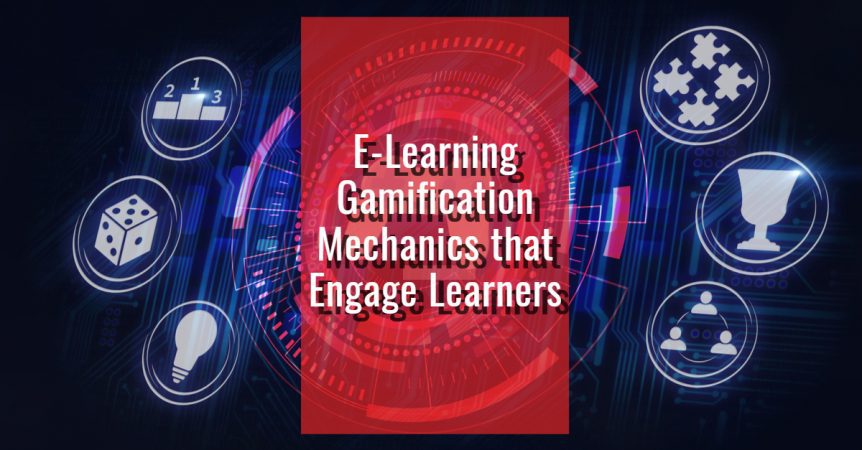E-Learning Gamification Mechanics that Engage Learners
When discussing the benefits of e-learning and the opportunities it presents, gamification is a topic that often comes up. There is a good reason for this too. When you get e-learning gamification right, your e-learning course is more likely to be a success.
Delivering on the practicalities to add gamified elements to your e-learning course requires the right skills. You will get those skills by hiring a professional e-learning developer that understands learners in the UAE and Saudi Arabia.
Whoever you use to develop the content, part of the discussion when planning gamified elements for an e-learning course involves deciding on the mechanics you will use. Those mechanics are typically borrowed from the gaming industry and are adapted for e-learning.
There are lots of e-learning gamification mechanics available, but the following are the most common. They are also usually the most effective.
Points
Points are a central feature of many gamified e-learning elements. It is a gamification mechanic that involves giving learners points for completing a task. You can then use the points you give to learners to unlock additional content, create an element of competition with other learners, or reward the learner in some way.
Badges
Badges have become very popular in mainstream games in recent years, but they are adaptable to e-learning. The process involves allocating badges based on achievement. This could be making progress in a course, getting a high score on a quiz, or completing another identifiable task.
Often you will add an overall task to the badge structure. For example, the e-learning course will challenge the learner to collect all the available badges.
Leaderboards
Leaderboards create competition among learners. When used in the right situation, learners will strive to get as high up the leaderboard as they can for kudos, recognition, or reward.
As with most gamified e-learning elements, there are several ways of approaching leaderboards, including using points and badges, i.e., the learner with the most points or badges sits at the top of the leaderboard. You can also use a scoring system, sorting learners on the leaderboard based on the highest quiz scores or the most completed modules.
Branching Scenarios
Branching scenarios are an e-learning element that is often included in its own category, but it is also considered to be a form of gamification.
They work by presenting the learner with a real-world scenario based on the content in the e-learning course. The learner is then asked to make a decision or take a course of action based on the situation. This answer by the learner changes the situation and creates a new set of options to choose from. In other words, everything the learner does and decides as they work through the scenario impacts the outcome.
By providing feedback and carefully structuring the flow, branching scenarios can be a powerful learning tool.
You can also gamify them even further by adding rewards, points, or badges.
Gamified Quizzes
Quizzes are a part of most e-learning courses and are not generally a gamified element. However, you can change how you present quizzes to give them a more gamified feel.
For example, instead of a set of questions the learner must answer, you can create visuals that resemble a board game with gameplay to match. The learner will still be answering questions, but it will feel more like they are playing a game.
Even adding a timer to a quiz and/or telling the learner how their score compares to others helps to gamify e-learning quizzes.
Levels
Like points, badges, and leaderboards, levels are very common in gaming. In most cases, you have to complete one level before you can move to the next.
It is common to structure e-learning content like this anyway, whether it is module-by-module within a course or across different courses. As a result, it doesn’t take much to tweak how you present the information and structure of the course to make it more like a game where progress involves moving up levels.
Self-Competition
Leaderboards and points are commonly used to add a level of competition between learners, but this isn’t your only option. You can also use a self-competition model by, for example, highlighting the highest quiz scores or personal best results.
You can also have both peer competition between learners and self-competition in the same course.
The main feature of self-competition is to encourage the learner to continuously improve by providing a benchmark to measure performance and then giving information on whether the learner is doing the same, better, or worse than before.
Cooperative Tasks
Our final example of a common gamification mechanic in e-learning is cooperative tasks. This typically involves working in a team remotely, in person, or a combination of both. Even something as simple as calling the task a challenge makes it feel more like a game. You can also add competition where teams compete against each other.
Engaging Learners with E-Learning
As with most content you include in your e-learning course, the gamification elements shouldn’t just be about making the content fun. Fun content is important as you want to ensure your e-learning courses are as engaging as possible. Making them fun is one way of doing so.
However, it is also important to use gamification elements to help those taking your course to learn, where the gamified element introduces new concepts, further explains ideas, or allows learners to practice and/or remember.
